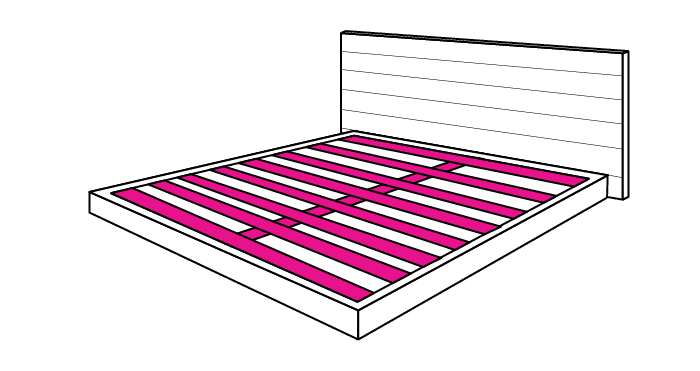Boxspring
A boxspring is a wooden, plastic, metal, or composite frame that contains a coil system within the framework to support the mattress above.

Why might you want one?
- High profile look
- Potential for additional bounce
- Some mattresses require it
Considerations
- May lack support or potential for sagging, especially with modern & heavier mattresses
- Usually heavy and difficult to move
Slats
A slat foundation uses flat, bowed, or flexible slats (wooden, metal, or composite) evenly spaced apart to provide support for the mattress above.

Why might you want one?
- Low profile look
- Easier to move + store
- Better support (usually)
- Affordable
Considerations
- May allow for sagging if not spaced properly
- Individual slats may break
- Cheap versions may look good, but lack support
In This Comparison
Which is Better? | Boxsprings | Bed Slats | Summary | FAQ
Are Boxsprings or Slats Better?
This is a bit of a loaded question since what is right for one person may not be right for others.
In today’s market, the traditional boxspring (with actual springs) is much harder to find. Third-party retailers like Amazon and Overstock rarely sell them (likely because of the logistical disadvantages of packing and shipping).
For this reason, bed slat systems or boxspring like foundations (coil-free) are growing in popularity since they are cheaper to produce, lighter / easier to ship, and provide better support (usually) for modern mattresses.
What is a boxspring?
A boxspring is traditionally a wooden or metal frame that contains a coil system within the framework to support the mattress above.

Here’s a quick rundown of the pros and cons.
Best For
- Innerspring mattresses
- Adding bounce
- Creating a higher profile aesthetic for the bed as a whole
Considerations
- More expensive to produce and ship
- Can be heavy or difficult to move
- Nearly doubles the height of the bed
Types of Boxsprings
There are two basic types of boxsprings.
- Coil Boxspring: uses traditional coils across the majority of the area, often combined with a wooden frame for support
- Modern Boxspring: has a metal or wood frame with horizontal pieces that span across the width of the boxspring. These slats support the mattress above, in the same way that the coil boxspring works.
Wooden Boxspring

Metal Boxspring

Low-Profile Boxspring

Folding Boxspring

Low-Profile Boxsprings
A traditional boxspring is anywhere from 8-10″ high. But when we nix the coils, boxsprings can actually be much shallower—even as thin as 4″ thick.
This is a good option if you’re looking for support, but want a sleeker aesthetic of a low-profile mattress.
Folding Boxsprings
Folding boxsprings can be a good solution for a supportive boxspring, that is also easier to move / store as well as being less expensive to ship.
What are bed slats?
Bed slats, also called slat foundations / frames use wooden or metal slats that are individually spread across the length of the mattress.

Best For
- A discreet, low-profile look
- Inexpensive and easy to ship
- Can be bought in a variety of configurations
Considerations
- Poor slat spacing can lead to sagging
- Some manufacturers still require traditional boxsprings
These slats are usually 2-4″ wide and placed 3-6″ apart.
Mattress brands oftentimes have guidelines as far as how far apart these slats should be. When slats are placed too far apart, the mattress can sag from insufficient support. In some cases, insufficient slat configuration can result in voiding your mattress warranty.
You can buy slats in three different configurations.
Slats Only: In this configuration, you can place the slats on top the bed frame wherever you need them and customize the spacing for optimal support. This is also a good option if you want to add additional slats to a bed frame or slat system that you already have. Slats can be placed freely or you can screw them into place.
Slats + Rails: To keep the slats in place, they also come pre-spaced and attached to a piece of velcro or webbing—two rails total, one on each side. This configuration comes rolled up (for affordable shipping) and you simply unroll and place it on your bed frame.
Slats + Frame: The last option is to purchase the slats and frame together. This is also sometimes called a bunkie board. This slat foundation is sturdy, supportive, and a great solution if you’re looking for an “all-in-one” option.
Which is right for you?
So you’ve made it this far… how do you know which foundation is right for you? Should you go with the boxspring or the bed slats? The answer may depend n what exactly you’re looking for.
For the best bang for your buck
I’d go with the slat + rail system or a folding boxspring. Both of these options would requre an exisitng bed frame, but aside from that expense, they are lower price and still offer great support.
For the best bounce
Coil-base boxsprings can sometimes add additional bounce to the bed, especially when combined with a coil-based mattress.
If you’re looking for bounce, you may want to go with a traditional coil-based boxspring. You might need to shop in-store options for this as online coil boxsprings are becomig harder and harder to find.
For a low-profile look
I would recommend any of the 3 bed slat configurations. Although a low profile boxspring can certainly help provide a modern aesthetic, slats add basically no extra height, so it’s hard to beat. Slats discreetly provide support and are not visible to the naked eye once you’ve added the mattress on top.
FAQ
Whether or not you need a boxspring is dependent on a few factors. Boxsprings are sometimes required by manufacturers. Other times they are necessary to provide additional support when the frame is insufficient or simply to make the bed taller.
For more info, check out our in-depth guide on when you need a boxspring.
No. Despite the name, a boxspring does not actually need springs. Support can be provided by wood, metal, or a composite material along the frame and a few slats across the width. The approach still creates a “box”, but skips the springs.
Boxsprings and foundations are often designed with a similar end goal—to support the mattress above it. And all technicalities aside, they tend to look pretty similar on the outside. But they are very different inside.
Technically, a box spring is a wooden or metal “box” framework with springs or coils that span the entire width and length.
A foundation is also a wooden or metal “box” framework, but does not include the coils or any other material inside.
A bunkie board is a 1-3″ solid platform that sits on a lower foundation (ie: metal bed frame, wood bed frame. collapsible bed frame, etc.) Unlike slats, which have spacing between each slat, a bunkie board is typically one or two pieces.
Also because it is solid (usually), bunkie boards may decrease cooling performance so be sure to consider that if you’re sensitive to heat retention or live in a humid area.
The short answer is yes. On a solid floor, a mattress receives plenty of support so a box spring is not necessary. But is it ideal to put your mattress on the floor? In some cases no.
Two reasons why you might want not want to put a mattress directly on the floor: (1) hygiene and (2) humidity. In any case, you should always follow your mattress manufacturer’s recommendations. Placing some mattresses directly on the floor may void the mattress warranty.






